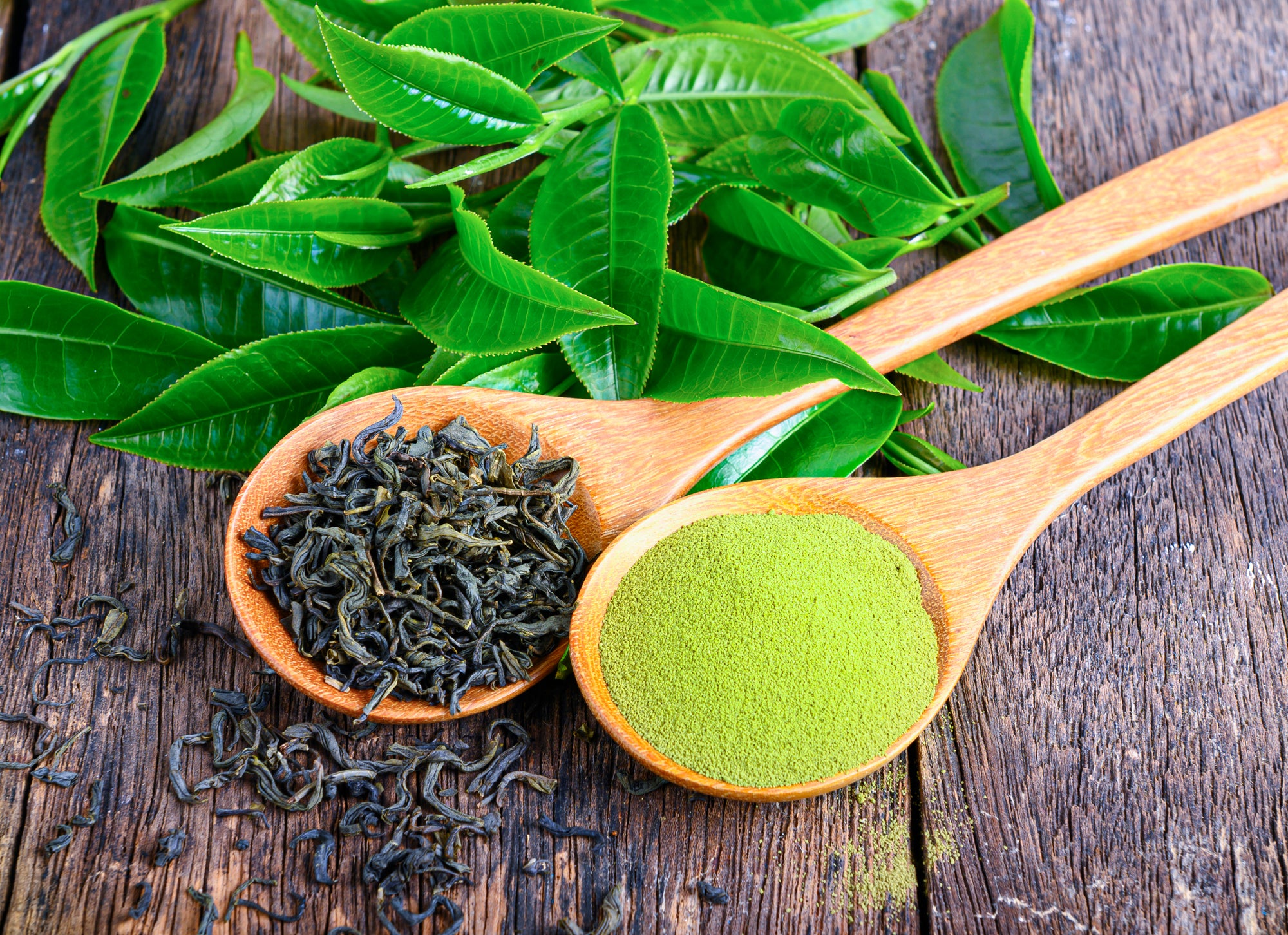
Tea — it's a comforting hug in a cup, a timeless ritual, and a friendly morning wake-up call. It's the go-to beverage for most of the globe, adored for its diverse flavors, enticing aromas, and its sneaky way of making us healthier. With all that the different kinds of teas have to offer, how do you pick the right one for what you're looking for?
Let's spill the tea on two hot contenders: green tea and matcha. Buckle up, it's time for a steep learning curve!
What is Matcha?
Hailing from China, green tea comes in three main styles: the humble tea bag, the sophisticated loose leaf, and the rich powdered type. Today, we're focusing on loose-leaf green tea and its powdered cousin, matcha. Both are the prodigies of the same plant parent, Camellia sinensis, steamed, pan fried and dried to create green tea — in fact, just two varieties of this species of tea are behind most of the tea we sip.
Matcha, with a deep-seated place in Japanese culture, has been cherished for centuries for its cultural significance and health-supporting properties. Legend has it that a Chinese monk introduced matcha to Japan in the 12th century.
Fast forward to now, and matcha has exploded onto the Western wellness scene like a supernova (and deservedly so). From traditional tea houses to hipster cafés, matcha is now a global sensation, celebrated for its soothing warmth and nutrient-packed, energy-boosting mojo.
How Do Matcha and Loose-Leaf Green Tea Differ?
Let's brew over some key differences that set these two apart.

1. Cultivation
Crafting matcha is like weaving magic — a time-honored, laborious process that gifts us with nutrient-packed, flavor-bursting tea leaves. This intricate process is probably why true, ceremonial-grade matcha (the Rolls-Royce of matcha tea) tops the price charts.
The most notable detail in matcha's upbringing is the use of a bamboo cloth as a sun shield. This ingenious trick blocks the sunlight’s leaching effects, preventing nutrient depletion and leading to a spike in antioxidants and amino acids. This sun shading also lets the leaves pump up their chlorophyll production, earning them their vibrant green hue.
Then, the leaves get the luxury treatment by being harvested by hand — and which leaves are picked determines the grade and quality of the matcha.
There are three main harvest periods for matcha throughout the year. The earlier the harvest, the more nutritious, bright, and flavorful the matcha. The crème de la crème, ceremonial grade matcha, is made from first harvest leaves — the youngest, softest leaves on the top of the plant — and boasts the brightest green color, smoothest texture, and most complex flavor profile.
Post-harvest, in order to maintain their color and halt oxidation, they are promptly steamed and then dried. The veins and stems of the leaves are then removed, often also by hand, and the leafy remains are stone-ground into a fine powder with a mill.
Loose-leaf green tea's journey, while less complicated, remains meticulous. The plants are sculpted and pruned to maintain size and sunlight exposure.
The tea leaves are then handpicked, laid out to wither, and steamed or pan-fired to keep oxidation at bay. Rolling the leaves, a critical step, releases flavor-boosting oils. Finally, the leaves are sun-dried and stored away.

2. Preparation Methods
Making matcha the traditional way might call for some specialty tools and a bit of practice, but the Zen-like ritual and ensuing feelings of energy make it worth the while.
First, warm your matcha bowl with hot water, then pour it out. Sift your chosen amount of matcha powder through a fine sieve into the bowl. Add a dash of hot water, then whisk it up until you have a smooth, frothy mix.
When matcha is ready to serve, it's often paired with Japanese candies, or wagashi, during tea ceremonies.
While the traditional method has a ceremonial quality to it and can even be meditative at times, it’s still perfectly acceptable to blend your matcha with an electric frother. In fact, this method is easier — especially for go-getters who mainly drink matcha for the health benefits.

Loose-leaf green tea, on the other hand, is more laid-back. Boil water, let it rest for just a bit until it gets down to about 175 degrees Fahrenheit/80 degrees Celsius, then pour it into your teapot or cup over the tea leaves. A couple minutes later, strain the leaves and then it's tea time!
Mind not to over-steep your green tea — it might throw a bitter tantrum. And if you fancy, dress it up with some lemon, honey, or other sweetener.
3. Caffeine Kick
Both matcha and regular green tea pack caffeine, but matcha is your sure bet for a sustained energy lift-off. Remember those shade-grown leaves? They retain more caffeine than their sun-basking buddies!
While loose-leaf green tea contains 11 to 25 milligrams per gram, matcha shoots up to 19 to 44 milligrams for each gram of tea. Factors including growing and harvesting practices account for the variations in level of caffeine in the tea.

4. L-Theanine Content
Ever wonder why coffee or soda might give you a caffeine buzz, but don't quite offer the serene aura of matcha and green tea? The secret is in the leaves!
That soothing alert-calm sensation you experience while sipping on green tea is all thanks to the unique combination of caffeine and an amino acid called L-theanine, found abundantly in Camellia sinensis plants. L-Theanine raises the level of brain waves and chemicals that promote tranquility without actually making you drowsy. A study showed that subjects were humming with brain waves signaling relaxation within just 40 minutes of consumption.
Matcha, with its nutrient-concentrating cultivation process, packs a substantial L-theanine punch, explaining why Buddhist monks have been brewing it for over a thousand years!
5. Nutrient Profiles
While neither tea is a heavyweight in macronutrients or brimming with a myriad of vitamins or minerals, matcha scores a few extra points in the nutrition department. Why? Because not only are the shade-grown leaves used for matcha more nutrient-rich – you also consume the entire leaf in its powdered form, instead of straining the leaves out.
A notable mention is that both teas are antioxidant superheroes. They're packed with specific antioxidant compounds called catechins, which reportedly outshine even vitamin C in their health-boosting effects.

6. Taste
Much like snowflakes, no two matcha or loose-leaf green teas are the same, so flavor profiles can vary depending on the quality of the tea.
Generally, matcha's taste can be described as:
- Earthy: Thanks to the chlorophyll-rich leaves, matcha often sports an earthy or grassy flavor that can surprise first-time samplers.
- Umami: Matcha packs a savory punch, also known as umami. This flavor is often linked to the amino acid glutamate, which is a close cousin of L-theanine.
- Bitter: Matcha might throw a slightly bitter curveball that takes some getting used to. But if brewed correctly (and high quality matcha is used), this bitterness is balanced by savory and sweet notes.
- Creamy: More a texture than a taste, a well-prepared matcha will glide over your tongue with a creamy smoothness that adds to the overall drinking experience.
- Sweet: While true matcha won't be candy-sweet, high-grade varieties do offer a touch of natural nutty sweetness to balance out the earthy and bitter notes.
At the end of the day, each cup of matcha will have its own flavor palette, influenced by the tea's cultivation, processing, and brewing. Top-tier matcha usually offers a more balanced and robust flavor, while cheaper versions might lean toward a bitter edge.

Loose-leaf green tea shares several flavor traits with matcha, but also brings its own unique notes to the table. An important note: these traits we’ll talk about are more notable with higher quality teas, so you won’t quite find them in the bulk grocery store variety or pre-brewed bottled teas.
Here are some tastes commonly associated with green tea:
- Earthy: Like matcha, green tea often brings a slightly grassy flavor and aroma to the table.
- Floral or Herbal: Many loose-leaf green teas come with a delicate floral or herbal flavor and aroma. For example, jasmine green tea is infused with jasmine blossoms for a more floral undertone.
- Bitter: The bitterness in green tea can vary depending on how it's brewed (read: peek that do-not-boil note we mentioned earlier!). However, many tea enthusiasts appreciate how this flavor balances the overall taste.
- Sweet: Again, high-quality green teas may present a natural sweetness that adds a counterpoint to the bitterness and earthy flavors.
- Refreshing: Green tea is famed for its light and refreshing persona. Unlike its oxidized counterpart black tea, it leaves your palate feeling crisp, clean, and ready for another delightful sip!
The Bottom Line
Reflecting on our tea-riffic journey today, it's clear that while matcha and loose-leaf green tea share many similarities, they also hold their own unique characteristics that make them stand out in the tea universe.
Matcha, with its nutrient-dense cultivation and all-consumed preparation, packs a powerful punch of caffeine, L-theanine, and antioxidant catechins. Its complex taste profile, with earthy undertones, subtle sweetness, and a dash of bitterness, makes each sip an adventure. If you're seeking a zen-like state of wakeful relaxation and a nutrient-rich brew, then matcha is your perfect tea-ceremony candidate.
On the other hand, loose-leaf green tea, with its simpler processing and gentler caffeine kick, offers a refreshing and balanced palate experience. Its earthy, floral, and slightly bitter flavors, combined with an often-underrated sweetness, provide a delightful sensory experience. If you're after a light, refreshing cup that still offers a healthy dose of beneficial compounds and a touch of calm, then loose-leaf green tea is your perfect tea-time companion.
In essence, whether you're a hardcore matcha maven or a green tea guru, both these teas offer a wealth of flavor and health benefits. They're both superstars in their own right, providing an amazing diversity of experiences for tea lovers worldwide. So, why not try both and see which one tickles your taste buds more?
Remember, like any good story, the joy of tea lies not in the destination but in the journey. So take a moment, brew a cup, and savor the intricate dance of flavors that these remarkable teas have to offer. After all, there's nothing quite like a well-brewed cup of tea to make any day a bit brighter!
